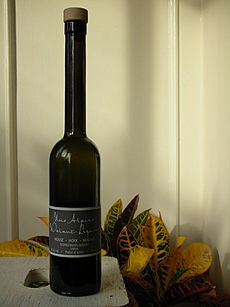Nocino facts for kids
Nocino is a dark brown liqueur from the Emilia-Romagna region in northern Italy. It is made from green walnuts that are not yet ripe. The walnuts and the liquid are handled using ceramic or wooden tools. This helps stop them from changing color. After soaking in spirit, the walnuts are taken out. Then, the alcohol is mixed with a simple sugar syrup.
Nocino has a strong, sweet, but slightly bitter taste. Many families and villages make their own Nocino at home. They often have secret recipes. These recipes can include different spices like cinnamon, juniper berries, lemon or orange zest, vanilla pods, coffee beans, or clove. The spices are added carefully so they do not hide the walnut flavor. The main liquid is usually pure alcohol, but vodka can also be used. Nocino is also sold in bottles in stores. Store-bought Nocino usually has about 40 percent alcohol by volume.
History of Nocino
Some old stories say that Nocino first came from Great Britain. Roman historians wrote about the Picts. These were people in Britain who painted their skin blue. The Romans said that on June 24, the Picts drank a special brew. They believed this drink helped them talk with goblins, elves, and goddesses.
When Christianity became the official religion of the Roman Empire around 313 AD, these old traditions changed. They became linked to Saint John the Baptist. He was born on the Summer Solstice, which is June 24.
While many people think Nocino is very old, there are not many written records from ancient times. However, Conrad Gessner wrote about a similar drink in his 1552 book. He said that "water of walnuts not rype made aboute saint Ihons tyde" was good for wounds and infections. This old drink used unripe walnuts collected on Saint John's Day. It also had some of the same ingredients as Nocino.
Nicholas Culpeper also wrote about green walnuts. He said that young green nuts, preserved with sugar, were good for people with weak stomachs. He also mentioned that a small amount of a walnut drink could help cool fevers and fight diseases like the plague.
This special drink then traveled to Celtic France. Even today, a similar drink called Brou De Noix is made there. Later, this way of soaking green walnuts came to Italy. There, it became known as Nocino. In the Piedmont region of Italy, it is called Ratafià Di Noci.
During the Middle Ages, monasteries in Italy used Nocino. They believed it had medicinal properties. The Ordine del Nocino Modenese is a group in Italy that works to promote traditional Nocino from Modena. They have been doing this since 1978.
Today, global warming is affecting when walnuts ripen. In some places, walnuts are too ripe for Nocino by June 24. Walnuts are best for Nocino when they are still soft and have not hardened. This means they might need to be picked earlier, sometimes in mid-June.
Where to Find Nocino Today
Nocino is made in many places around the world. In New Zealand, a company called NewZino makes it as NutZino Walnut Liqueur. In Australia, you can find it from the Timboon Railway Shed Distillery and Osare - Liquori della Tasmania.
A few small distilleries in the United States also make Nocino. These include Long Road Distillers in Grand Rapids, Michigan and Watershed Distillery in Columbus, Ohio. In Canada, The Woods Spirit Co. offers both traditional and barrel-aged Nocino.
Other countries also make similar walnut drinks. In Romania, it is called Nucată. People drink it for enjoyment and to help with digestion. The Romanian recipe often includes other flavors like anise, black pepper, lemon peel, orange peel, nutmeg, or vanilla pods. Sometimes, Romanians use the softer walnuts to make walnut jam at the same time. This is because walnuts are good for both uses in June. Some people in Romania also make walnut liquor in autumn from the green husks of walnuts.
In Slovenia, walnut liquor is known as orehovec. It is often flavored with coffee. In Croatia, it is called Orahovac and has orange, lemon, and vanilla flavors. In Serbia, it is known as orahovača. Many families make it at home in villages. It is thought to be very good for health.
See also
 In Spanish: Nocino para niños
In Spanish: Nocino para niños


